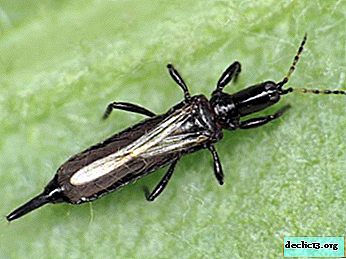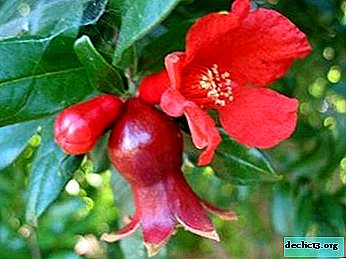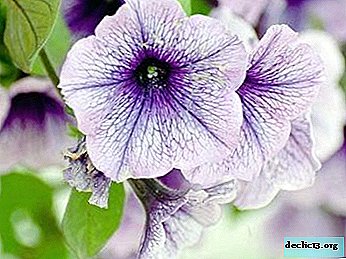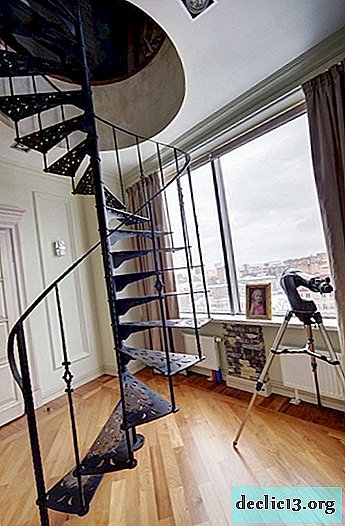What are thrips on indoor plants and how to deal with pests?

Thrips are small insects that do great harm to indoor plants. If pests are found, a fight should immediately begin with them.
If thrips are not destroyed on time, the plant will die. You can fight with thrips using chemicals or more gentle means, prepared independently.
The article describes in detail why the pest appears, what are the signs of infection, how to fight and by what means, how to properly treat the plants, and what preventive measures to take to avoid trouble.
What is it, where does the flower pest come from?
Thrips can get on a houseplant in several ways:
- From a purchased plant.
- With a process taken from friends.
- With soil. It can be purchased, typed in the forest or in the garden.
- With cut flowers from the garden.
- Fly in the window if there is a flower garden nearby.
Chemicals - their description, prices and instructions for use
To combat insect pests, there are special chemicals. They can be bought at any store for gardeners and gardeners. Get rid of thrips will help drugs such as:
- "Aktara";
- Fitoverm;
- Confidor
- Actellik.
On the packaging of the chemical preparation should be indicated that it is suitable for the treatment of indoor plants.
Aktara
"Actara" is an insecticide that combines contact and intestinal action. It is sold in the form of granules in 4 g sachets or in a jar of 250 g. 4 g is enough to process indoor plants.
"Actara" begins to act 20-30 minutes after application. She is not afraid of water and therefore the treated plant can be watered as usual. This drug works equally effectively at low and high temperatures, with high humidity and hot sunny weather.
"Actara" almost immediately after treatment begins to penetrate into the leaves and soil. When spraying, the plant remains under the protection of the drug for another 18-20 days, and when processing the soil - about 40-60 days.
This medication is easy to apply. For 4 g, you need 5 liters of water with a temperature of +25 degrees. This amount of solution is enough for about 125 plants. If there are few indoor flowers, then you can dilute 1 g of Actara in 1.25 g of water.
It is not always possible to spray plants. In this case, you can water the flower with a diluted preparation. To do this, 1 g is diluted in 10 liters of water, heated to 25 degrees.Depending on the manufacturer, 4 g of "Actara" costs from 140 to 200 rubles.

Fitoverm
The drug "Fitoverm" refers to biological pesticides. Its active substance Aversectin C does not accumulate in plant tissues and decomposes within 12 hours. Acts as a contact and intestinal biopesticide.
"Fitoverm" protects the plant for 20 days after application. But only under the condition of high temperature in the room. If the plant grows in a cool and humid place, then the duration of the drug can be reduced to 1 week.
Use only freshly prepared solution. With prolonged storage, it loses its properties.
Sold "Fitoverm" in ampoules of 2, 4 ml or in bottles from 10 to 50 ml. This drug is inexpensive: 4 ml can be bought at a price of 10 to 50 rubles, depending on the manufacturer.
To get rid of thrips, it is necessary to dilute 2 ml of Fitoverma in 200 ml of water. Spray the plant within 1 hour after preparing the solution. "Fitoverm" is not intended for soil irrigation. Re-treatment is recommended after 4-5 days.

Confidor
Confidor is a systemic insecticide. The drug protects the plant for 1 month. For processing indoor flowers it is convenient to use "Confidor" in the form of a powder (granules). Powder is sold in bags of 1, 5 g.
Confidor is poorly soluble in hard water.
For prevention and with a small infection with pests, a dosage of 1 g per 10 liters of water is sufficient. If there are a lot of insects, then you need to dilute 2 g of the drug per 10 liters of water.
1 g "Confidor" in the store can be bought at a price of 40 to 60 rubles.

Actellik
The drug "Actellik" is a systemic pesticide that is part of the group of organophosphorus insecticides. It has a contact and intestinal effect on insects. The protective effect of the drug lasts 1-2 weeks. After this period, it is recommended to re-process the plant.
"Actellik" is available in ampoules of 2.5 ml and in jars of 50 and 100 ml. At the store, 2 ml of Actellika can be bought for 10-27 rubles, and 5 ml for 25-45 rubles.
To treat indoor plants from pests, you need to dilute 2 ml of the drug in 1-1.5 liters of water. The prepared solution is immediately sprayed on the plant or the leaves are wiped on both sides.
The diluted drug can not be stored and used in the future.

Flower Processing Plan
To successfully deal with thrips, you need a systematic approach. A single treatment will not give the desired result. It should be remembered that:
- processing plants at temperatures below +18 degrees will be useless;
- if the average daily temperature is in the range of 22-24 degrees, then re-treatment should be carried out after 7-8 days;
- at an average temperature of 25-28 degrees, the plant is re-processed after 5-6 days;
- processing is repeated after 10-12 days if the temperature has settled within 20-15 degrees.
To destroy pests, you need to treat the plant with drugs 3-4 times. When spraying, it is not necessary to place the plant in a plastic bag.
Important! If pests are found on one flower, it is necessary to treat all the plants in the house with chemicals.How to get rid of with the help of folk remedies?
 Chemicals are effective, but toxic. If there are few pests, then you can notice more gentle preparations prepared at home:
Chemicals are effective, but toxic. If there are few pests, then you can notice more gentle preparations prepared at home:
- To 200 ml of water add 1 teaspoon of chopped onion or garlic. After a day, the tincture will be ready and you can process the plant.
- A half-liter jar should be filled with dry flowers of marigolds and allowed to stand for several days. The filtered infusion processes the ground part of the flower.
- 50 g of fresh leaves of dandelion is poured with 1 liter of warm water, filtered after three hours and you can spray the plant.
- In one liter of water add 100 g of dried chamomile flowers and insist 12 hours. After filtering, 5 g of green soap is added to the mixture and the affected areas are wiped. After 24 hours, the mixture from the plant should be washed off with warm water.
- The affected flower can be treated with infusion of flowering celandine. For this, 50 g of celandine is poured with one liter of water and insisted for a day.
- 100 g of dry powdered tobacco is insisted in 1 liter of water. Another liter of water is added to the filtered solution and the affected plant is sprayed.
- 50 g of dried leaves of tomato is poured into 200 ml of water and infused for three hours. After straining, 800 ml of water is added and the plant is treated.
- A small container is filled with chopped garlic or turpentine, put in a pot with the affected plant and covered with a plastic bag for three hours.
Description and photo of signs of defeat, methods of struggle
For all plants, there are common signs of thrips:
- small black or colorless dots appear on the leaves;
- the plant fades prematurely, inflorescences become smaller, leaves, stems, flowers are deformed;
- silver or white cobwebby plaque;
- a leaf-like net, brown and dark spots are formed on the leaves and flowers.
Next, it will be described how this pest looks in different colors, a photo is shown and it is told how and what to process the plants.
On violets
The thrips larvae hit the anther of violet flowers. The fact that thrips wound up on the violet can be understood by such signs as:
- dropped leaves;
- foci of drying;
- twisted edges;
- showered pollen.
If signs of infection are detected, the flower must:
- Separate from other plants and treat with an insecticide.
- You can cover the violet with a plastic bag for a day.
- After two weeks, a second treatment is necessary.

We suggest watching a video about the signs of the appearance of thrips on a violet and pest treatment method:
On ficus
The main sign that thrips settled on the ficus is the yellowness of the leaves. Over time, they dry out and fall off. The affected plant must be separated from others and sprayed several times with insecticides.

On the roses
Thrips love to settle in unblown rosebuds. As a result, they do not bloom and dry out. Buds in which thrips are found must be cut immediately. The root system of roses should be treated several times with an interval of 10 to 14 days.

In phalaenopsis
On orchids, thrips is manifested in the formation of a thin film on the leaves, followed by their drying and dying. First of all, it is necessary to remove the affected areas. Before treating phalaenopsis with chemicals, it is recommended to wash it with warm water. The plant is sprayed every 10 days until complete recovery.

We offer you to watch a video about the signs of the appearance of thrips on the phalaenopsis and the pest treatment method:
On cyclamen
A distinctive sign of the defeat of cyclamen thrips is the twisting of the leaves up. Pests on cyclamen are destroyed as well as on orchid:
- All damaged leaves and peduncles should be removed.
- And after bathing in warm water, treat with insecticides with a frequency of 2-3 times a week.

Can cyclamen seeds be infected?
Thrips can lay larvae in cyclamen seeds. At high temperatures and low humidity, they begin to get out and actively multiply.
Preventive measures
The best way to prevent thrips on indoor plants is prevention. It includes several actions:
- The new plant must be quarantined. A flower bought or taken from acquaintances should be kept for 2-3 weeks separately from other plants to detect signs of infection.
- After handling infected plants, wash your hands with soap.
- Keeping indoor plants clean.
- Thrips do not like humid air and low temperatures, so in the dry and hot period it is worthwhile to carefully monitor the condition of the flowers.
- Hanging adhesive tapes will save plants from flying thrips.
Thrips multiply very quickly. If you do not start a fight with them in time, you won’t be able to save the plant. Therefore, you need to inspect the flowers more often to detect the first signs of infection.
Useful video
We suggest watching a video about what kind of pest is thrips, what signs indicate its occurrence, and also with what means to deal with it:
















